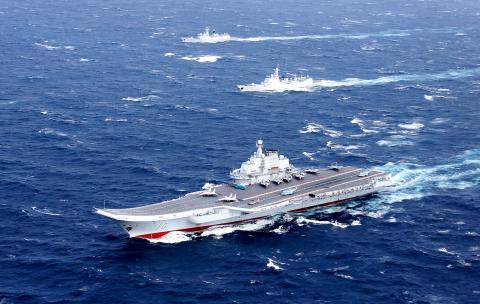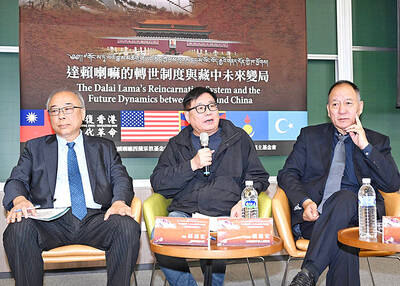The Ministry of National Defense (MND) yesterday said that a flotilla of Chinese military vessels had passed through the Taiwan Strait earlier in the day, heading southward along China’s east coast, after conducting a military exercise near the Japanese island of Miyakojima.
A destroyer, a supply ship and an escort vessel from China’s South China Sea fleet passed through the Miyako Strait — which lies between Miyakojima and Okinawa — into the Taiwan Strait, the ministry said.
The flotilla was traveling west of the median line in the Taiwan Strait and was expected to leave Taiwan’s air defense identification zone by last night, the ministry said, adding that it was closely following the ships’ movement.

Photo: Reuters
The three vessels were returning from an annual naval and air exercise that was conducted on Thursday in an area southeast of Miyakojima, which is about 300km east of Taiwan, the ministry said.
The exercise included drills involving fighter aircraft, early warning and air surveillance aircraft and Xian H-6 bombers, the ministry said.
It said there was no imminent threat to Taiwan, but the nation would continue to keep a close eye on China’s military actions and it is prepared to respond if necessary.
In December last year, China’s first aircraft carrier, the Liaoning, and a flotilla of escort vessels sailed close to Taiwan’s east coast on its way to the South China Sea to conduct training exercises.
On the return leg in January, the flotilla entered Taiwan’s air defense identification zone from the southwest and remained west of the median line of the Taiwan Strait, sailing north to its base in northeastern China.
In response to reporters’ queries, Taiwanese military expert Erich Shih (施孝瑋) said it was difficult to determine whether the aim was to intimidate Taiwan.
China was more likely was trying to gain maritime navigation experience with its military vessels, he said, adding that the targets of the exercises could also have been Japanese or US military bases in the region.

ALIGNED THINKING: Taiwan and Japan have a mutual interest in trade, culture and engineering, and can work together for stability, Cho Jung-tai said Taiwan and Japan are two like-minded countries willing to work together to form a “safety barrier” in the Indo-Pacific region, Premier Cho Jung-tai (卓榮泰) yesterday said at the opening ceremony of the 35th Taiwan-Japan Modern Engineering and Technology Symposium in Taipei. Taiwan and Japan are close geographically and closer emotionally, he added. Citing the overflowing of a barrier lake in the Mataian River (馬太鞍溪) in September, Cho said the submersible water level sensors given by Japan during the disaster helped Taiwan monitor the lake’s water levels more accurately. Japan also provided a lot of vaccines early in the outbreak of the COVID-19 pandemic,

Kaohsiung Mayor Chen Chi-mai (陳其邁) on Monday announced light shows and themed traffic lights to welcome fans of South Korean pop group Twice to the port city. The group is to play Kaohsiung on Saturday as part of its “This Is For” world tour. It would be the group’s first performance in Taiwan since its debut 10 years ago. The all-female group consists of five South Koreans, three Japanese and Tainan’s Chou Tzu-yu (周子瑜), the first Taiwan-born and raised member of a South Korean girl group. To promote the group’s arrival, the city has been holding a series of events, including a pop-up

TEMPORAL/SPIRITUAL: Beijing’s claim that the next Buddhist leader must come from China is a heavy-handed political maneuver that will fall flat-faced, experts said China’s requirement that the Dalai Lama’s reincarnation to be born in China and approved by Beijing has drawn criticism, with experts at a forum in Taipei yesterday saying that if Beijing were to put forth its own Dalai Lama, the person would not be recognized by the Tibetan Buddhist community. The experts made a remarks at the two-day forum hosted by the Tibet Religious Foundation of His Holiness the Dalai Lama titled: “The Snow Land Forum: Finding Common Ground on Tibet.” China says it has the right to determine the Dalai Lama’s reincarnation, as it claims sovereignty over Tibet since ancient times,

Temperatures in some parts of Taiwan are expected to fall sharply to lows of 15°C later this week as seasonal northeasterly winds strengthen, the Central Weather Administration (CWA) said today. It is to be the strongest cold wave to affect northern Taiwan this autumn, while Chiayi County in the southwest and some parts of central Taiwan are likely to also see lower temperatures due to radiational cooling, which occurs under conditions of clear skies, light winds and dry weather, the CWA said. Across Taiwan, temperatures are to fall gradually this week, dropping to 15°C to 16°C in the early hours of Wednesday